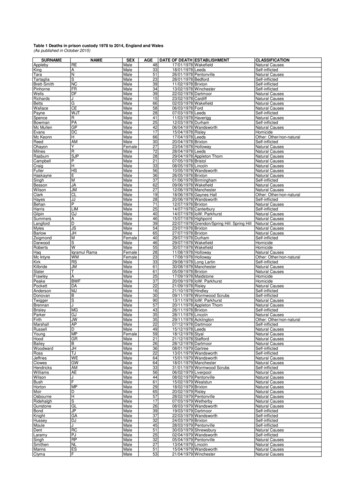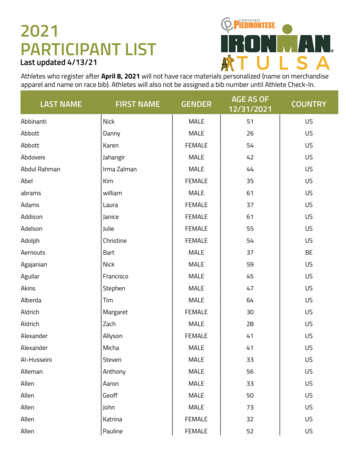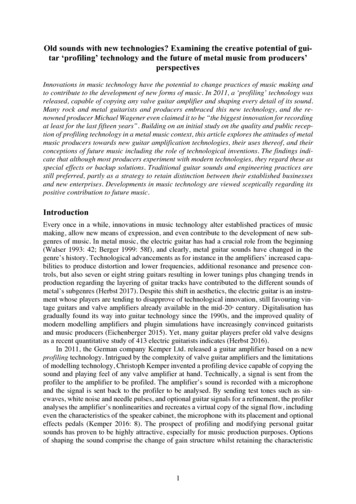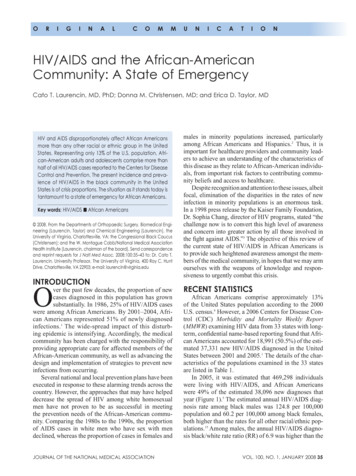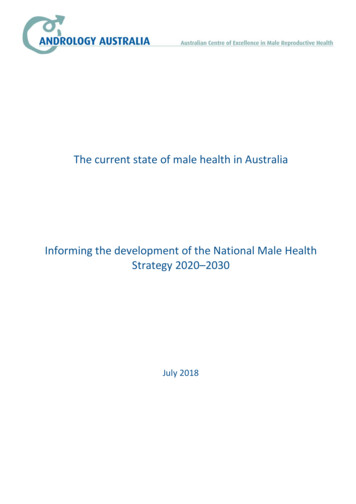
Transcription
The current state of male health in AustraliaInforming the development of the National Male HealthStrategy 2020–2030July 2018
Table of contentsExecutive Summary. 4Introduction . 6Methods and limitations . 6The demographics of Australian males in context . 8A health snapshot - Australian males in 2018 . 10Delving into specific causes of health burden in Australian males . 15Chronic disease - overview . 16Chronic disease – Cardiovascular disease and Type 2 diabetes . 17Chronic disease – Respiratory disease . 19Chronic disease – Bowel cancer . 20Chronic disease – Dementia . 21Mental health and wellbeing . 22Injuries . 25Male sexual and reproductive health . 28Sexually-transmitted infections and blood borne viruses . 34Risk factors and health-seeking behaviours . 40Prevalence of key risks factors in Australian males . 43Health literacy, access and help-seeking in Australian males . 46Health equity across population groups of Australian males. 47Health across the life course of Australian males . 51References. 52The current state of male health in Australia, 20182
List of abbreviations used in this reportABSAustralian Bureau of StatisticsAIDSAcquired Immune Deficiency SyndromeAIHWAustralian Institute of Health and WelfareARTAssisted Reproductive TechnologiesBRCA1/2Breast cancer related gene mutation also related to prostate cancerCALDCulturally and linguistically diverseCHDCoronary heart diseaseCOPDChronic obstructive pulmonary diseaseCVDCardiovascular diseaseDALYDisability-adjusted life yearsDNADeoxyribonucleic acidLGBTIQA Lesbian, gay, bisexual, transgender, intersex, queer, asexual, otherHDLHigh density lipoproteinHIVHuman Immunodeficiency VirusICSIIntracytoplasmic sperm injectioniFOBTFaecal occult blood testIVFIn vitro fertilisationLUTSLower urinary tract symptomsMATeSMen in Australia Telephone SurveyOECDOrganisation for Economic Cooperation and DevelopmentPBSPharmaceutical Benefits SchemePSAProstate specific antigenPYLLPotential years of life lostSTISexually transmitted infectionWHOWorld Health OrganisationYLLYears of life lostTerms used in this reportThe term male is used throughout this report referring to boys and men across the life courseAboriginal and Torres Strait Islander males, females or people are used to describe people who identifythemselves as Aboriginal and/or Torres Strait IslanderNon-Indigenous is the descriptor used for Australians who do not identify as Aboriginal and/or TorresStrait IslanderThe current state of male health in Australia, 20183
Executive SummaryIn global terms, Australian men and boys experience good health and wellbeing, with the eighthhighest male life expectancy (80.4 years) of the Organisation for Economic Co-operation andDevelopment (OECD) countries in 2016.1 Australia is one of only 12 countries to have a male lifeexpectancy over 80 years. As is true for all Australians, the health of Australia’s males has improvedover time as evidenced by many indicators tracking health over time; however, there are specific areasof male health where gains have not been made and these require particular focus, either across thewhole population or for specific population groups.Why we need a male health strategyAustralian males are diverse in age, social and economic circumstances, culture, language, education,beliefs and a range of other factors that influence health behaviours and outcomes, and access tohealth care and education. These factors, as well as biological differences, mean that the healthexperience of males can be different to females and in some areas males experience poorer health.There are multiple areas in which Australian males are experiencing ill health and premature mortality.Males experience a greater share of the total fatal and non-fatal burden of disease – dying at youngerages than Australian females and more often from preventable causes.There are also population groups of males with poorer health outcomes who require targetedinterventions. These groups include Aboriginal and Torres Strait Islander males, migrants and thosefrom culturally and linguistically diverse (CALD) backgrounds, males experiencing socioeconomicdisadvantage and males residing in rural and remote areas. Other groups with specific health needsinclude gay, bisexual, transgender, other gender and sexually diverse males and males with disabilities.The need to systematically address the health of males has been recognised globally; notably Australiais one of only four countries in the world with a national male health policy.“Better health for all cannot be achieved if the many challenges currently facing menare left hiding in plain sight.”2It is important that this is not viewed as a binary choice between tackling male or female health. To thecontrary, a complementary approach is advocated for whereby a gendered lens is applied to assessspecific needs. The resultant male, female and general health policies, programs and services and theirpotential for meaningful and lasting impact is thus optimised and, through their implementation, willcontribute to the health of all – Australian males, females, our families and communities.The good newsIn this review, promising trends were observed in recent years across a series of conditionscontributing to the health burden experienced by Australian males and associated risk factors. Theseinclude decreases in: Deaths from coronary heart disease, stroke, lung cancer, bowel cancer, road accidents, workrelated accidents and prostate cancerHospitalisations due to assault, accidental poisoning, thermal causes and drowningGonorrhea and hepatitis B infections in Aboriginal and Torres Strait Islander males and HIVdiagnoses in the general populationSmoking rates.The current state of male health in Australia, 20184
The challengeDespite these promising changes, the health burden experienced by Australian males remains high andpremature mortality from injuries, suicide and a series of chronic diseases remain at levels that aresignificantly higher than what we see in Australian females. For example: Older males have a high burden due to coronary heart disease and growing burden due todementia and fallsYoung adult males have high levels of mental ill-health and deaths from preventable causes suchas suicide and accidents. Low levels of risk perception and high levels of risk taking are contributingto many years of life unnecessarily lostAboriginal and Torres Strait Islander males have higher rates of fatal and non-fatal burden foralmost every condition considered in this review, and have a high prevalence of risk factors andrisk taking behaviours.The way forwardThere are multiple clear areas for consideration emerging from this evidence review wherebymeaningful progress can be charted towards healthier lives for Australian males. They include: Improving awareness of healthy lifestyles, risks to health and wellbeing (for males themselves aswell as the impact on families and communities)Promoting self-determination – healthy choices and healthy behaviours: reducing risk andpreventing disease, injury and premature mortality; increasing engagement of males as fathers,future fathers and as positive role models in their families and communitiesDestigmatising mental ill-health and help-seekingImproving access to services including male-focussed health and service promotion and provisionto break down the barriers to male engagement with their own health and the health systemFocussing efforts on closing the health burden gap between males from different populationgroups and life stagesIdentifying gaps in our knowledge about the health of Australian males and determine prioritiesfor research that can contribute to the evidence base for effective interventions in male healthDefining a vision and targets for male health and associated measures that can be tracked overtime to monitor progress and inform priority setting.The current state of male health in Australia, 20185
IntroductionTo reduce the health burden in Australian males in a meaningful way, we must consider: the specifichealth issues and needs of males; the social contexts and norms influencing male health andwellbeing; and the health-related knowledge and practices of Australian boys and men.The first ever Australian National Male Health Policy was launched in 2010.3 In 2018, it is timely toreassess the health of males, to reflect on gains and areas of current need, and to prepare for thehealth challenges facing men and boys now and into the future.This paper has been developed as part of a process to inform the development of the National MaleHealth Strategy 2020–2030. A parallel process is being undertaken to develop the National FemaleHealth Strategy for the same time period. This paper draws on an evidence review process designed tocapture evidence of male health trends, issues and needs since 2010. It is designed to inform aRoundtable discussion to be held in August 2018 where Key Opinion Leaders will discuss and debatethe opportunities to reduce the burden of illness, injury and premature mortality for Australian males.Outcomes will form the basis for the development of a draft Strategy that will undergo a period ofpublic consultation in November 2018 before it is finalised in early 2019.Methods and limitationsThis evidence review was undertaken over a six-week period in June and July 2018. Due to the volumeof evidence and the breadth of subject material to cover, pragmatic choices were made aboutmethods and scope for this review. It was not possible to undertake a comprehensive systematicliterature review and so targeted searches were undertaken seeking updated statistics across theareas defined in the 2010 National Male Health Policy, in addition to some new areas that wereidentified as a priority for consideration in this review. This was focused on informing consultationsinto the key focus areas identified for the National Male Health Strategy: mental health; chronicdisease and preventive health; injuries and risk-taking behaviour; diseases the exclusively ordisproportionately affect males; healthy ageing and research needs.Key sources were accessed from the Australian Bureau of Statistics (ABS) and Australian Institute ofHealth and Welfare (AIHW) and equivalent bodies (depending on the topic area). Literature searcheswere undertaken to supplement material accessed through these core datasets or studies, and to seekinformation to create the picture for each condition or issue: current prevalence; trends over time;population groups specifically affected; and risk factors. Where rates are reported in this documentthey are age-standardised unless otherwise specified.The following limitations are noted: It is possible that more current data are available that are not included in this document due to thetargeted rather than systematic approach to data collectionIn some instances, recent data were not available and so older data sources (pre-2010) were usedIn the data accessed, reporting of statistics and stratification of variables (such as age ranges,population groups) were not always consistent, which at times hindered the potential forcomparison between data reported over timeHealth data for men from specific population groups is not easily accessible for all healthindicators; much of the data in ABS and AIHW reports for specific population groups are presentedfor males and females combined. In instances where only combined data for males and femaleswere accessed, these data are presented using the general terms of Australians or peopleIt is important to remember that some of the characteristics used to separate men into populationgroups overlap as different groups share common risk factors for ill-health. For example,Aboriginal and Torres Strait Islander males are more likely to live in remote locations with pooreraccess to services, less educational and employment opportunities and more socioeconomicdisadvantage, all factors potentially contributing to poorer health outcomesThe current state of male health in Australia, 20186
Accurate incidence and prevalence data for certain health conditions (e.g. dementia, mental illhealth) are not always available. Dementia estimates are based on international information,adjusted for the Australian context.4 Much of the mental health data rely on self-reportingWhen considering non-fatal burden or morbidity, data on hospitalisations can provide animportant snapshot on an issue but it does not reflect the whole story. There are gaps in coredatasets for people who are not hospitalised for their condition including those seen in emergencydepartments only, as well as those who receive care in primary health and community healthsettings, or in private specialist or allied health servicesSuicide and self-harm data are reflected in two sections: Mental health and Injuries. This reflectsgovernment reporting of those conditionsIt is important to note that the male and female evidence reviews that are being undertaken haveoccurred in parallel and so different approaches may have resulted.The current state of male health in Australia, 20187
The demographics of Australian males in contextSome key statistics are outlined in Box 1 framing the demographics of the Australian male population.Box 1: Demographic snapshot of Australian males In June 2017, an estimated 12.2 million males were living in Australia (49.6% of the population)5 Sixty-eight per cent of males in 2017 were younger than 50 years of age and 14.5% were 65 yearsof age or older. Australian males, overall, had a younger age distribution than Australian females(see Figure 1)5 An estimated 373,000 or 3.1% of Australian males identified as Aboriginal and/or Torres StraitIslander in the 2016 Census. Thirty-four per cent were under 15 years of age, compared to 19% ofnon-Indigenous males (Figure 1). In the age group 65 years and over there were 85 males for every100 females, reflecting earlier mortality amongst Aboriginal and Torre Strait Islander men6 The 2011 Census showed that more males than females live in remote locations (116 males forevery 100 females) although the vast majority of our population live in major cities (69%) or innerregional areas (19%); 9.3% live in outer regional areas and 2.5% in remote or very remote areas a 6 Twenty-seven per cent of Australian males in 2016 were born overseas – with the main countriesof birth being: United Kingdom, New Zealand and China6 Just under 22% of males indicated in 2016 that the main language spoken at home was notEnglish7 Significant numbers of males experience high levels of socioeconomic disadvantage. In 2016, 13%of males lived in poverty, about 59,000 were homeless and 36,000 males were in adult correctiveservices custody6 In 2017, 66% of males aged 15 years and over were employed and 60% of males aged 15–74 yearshad a non-school qualification6 In 2015, 18% of Australian males were reported as living with a disability8aNote, the 2016 Census remoteness data stratified by sex will be published later in 2018; data is presently only for ‘persons’.The current state of male health in Australia, 20188
Figure 1: The Australian population in context: age distribution by sex and Indigenous status9The current state of male health in Australia, 20189
A health snapshot - Australian males in 2018A snapshot of the health of Australian males in 2018 is presented below drawn from the most recentlyavailable data. Different dimensions were captured to assist in the consideration of the relative healthburden (fatal and non-fatal), life expectancy, causes of burden and changes over time. Box 2 provides ageneral snapshot reflecting self-assessed health status, life expectancy and disability-free lifeexpectancy of Australian males.Box 2: Health status and life expectancy of Australian malesSelf-assessed health status gives a general picture at one point in time of a person’s perceived healthstatus and provides a broad measure of a population’s health In 2014/15,10 55% of males aged 15 years and over rated their heath as excellent or very good. Theresponse from females was similar with 58% rating their health as excellent or very good In 2014/15,10 younger men rated themselves as having better health than did older men: 64% ofmales 25–34 years old and 32% of males aged 75 years and over rated their health as excellent orvery good, slightly lower than females – 67% and 36%, respectively Self-assessed health status has stayed fairly constant over time with similar proportions ofAustralians rating their health as excellent or very good in 2011–12 and 2007–0810Life expectancy for males has increased over time and the gap between female and male lifeexpectancy has decreased For males born in 2005–07 life expectancy was 78.7 years11 increasing to 80.4 years for males bornin 20166 In the same time period, life expectancy for Australian females also increased but the gap in lifeexpectancy between males and females has narrowed slightly (from 5.0 to 4.2 years)11; 12 It is important to note that a similar sex discrepancy in life expectancy is evident in many othercountries; the average life expectancy at birth for males across OECD countries in 2015 was 77.9years compared to 83.1 years for females, a gap of 5.2 years1Disability-free life expectancy reflects the life and health expectancies at age 65 – an importantindicator of healthy ageing In 2013–2015, life expectancy for men aged 65 years was just under 20 years; nine of those yearsare expected to be free of disability and 10 years with some disability, including three years withsevere disability6 For the purposes of comparison, for women aged 65 years in 2013–2015, life expectancy was justover 22 years; 10 years free of disability and 12 years with some disability, including six years withsevere disability12Almost 82,000 Australian males died in 2016 with the ten leading causes comprising over half of maledeaths (Figure 2). The fatal burden is further explored in Figure 3 where data are presented for Yearsof Life Lost (YLL). This measure includes the number of deaths but also the age at death, reflectingdiseases contributing to a higher level of premature mortality.13; 14The current state of male health in Australia, 201810
Figure 2: Ten leading causes of death in Australian males in 2016 b 13Figure 3: Ten leading causes of fatal burden (YLL) in Australian males in 201514M a leF a ta l b u r d e n ( Y L L ; 2 0 1 5 )15F e m a eDr0bFemale data included as comparator for each of the top ten causes in males; CHD coronary heart disease; COPD chronicobstructive pulmonary diseaseThe current state of male health in Australia, 201811
Box 3: Causes of death in Australian males – an overview and trendsAustralian males are dying at higher rates than females from suicide, coronary heart disease andlung cancer The top causes of death are similar for males and females, although occur in a different rankingorder (including prostate cancer and breast cancer as the sixth leading cause of death in males andfemales respectively and tenth ranked causes of fatal burden)13 Suicide does not appear within the top ten, nor in fact, in the top 20 causes of death in females.Like in other developed countries, there are especially high rates of suicide in Australian malescompared to females – in 2015, the male suicide rate was more than three times the rate infemales after adjusting for age6; 15 Males died from coronary heart disease (CHD) and lung cancer at twice the rate of females afteradjusting for age, in 20154There are important trends to note over time In the decade 2006–2016, encouraging trends show decreasing deaths from CHD; cerebrovasculardisease (stroke) and lung cancers, whilst deaths from chronic obstructive pulmonary disease(COPD), dementia and type 2 diabetes have increased.4 Bowel cancer deaths have also decreasedover time (1982–2017) as have deaths due to prostate cancer (2010–2015) 4; 6 Dementia has emerged in these data as a significant cause of death in Australian males. This wasnot highlighted within the 2010 National Male Health Policy and has been impacted on by changesto the coding of deaths leading to more causes of death due to dementia being counted.16 Theresult is the recognition of dementia as the third leading cause of death in Australian males. Whilstthe burden of dementia is higher in females, it reflects an area of significant burden of disease anddeath in males that requires consideration6 Specific trend data for age-standardised rates of suicide are not available but deaths from suicidehave been noted as increasing in the rankings of causes of death since 20064Premature and preventable mortality provides an important area for focus and intervention toimprove the health of Australian males. Box 4 outlines key statistics and trends in preventablemortality and their causes.Box 4: Premature and preventable deaths in Australian malesAustralian males are dying at younger ages than females and more often from preventable causes The 25–64 years age group is where most preventable deaths occur. In 2016, 20% of all maledeaths occurred in this age group compared to 13% of female deaths. This was slightly lower thanin 2006 (22% of male deaths and 14% of female deaths)17 Of all premature mortality in 2016, 62% occurred in males6 and 38% in females. This was similar tothe sex breakdown in 201318 In 2005, males experienced 75% more potential years of life lost (PYLL – an indication ofpremature mortality c) than females19cA measure of premature mortality based on the number of years between the age at death and 75 years, assuming 75 is anaverage age of dyingThe current state of male health in Australia, 201812
Box 4: Premature and preventable deaths in Australian males (continued) In 2011, males had 1.6 times the rate of fatal burden of disease than females after adjusting forage (measured by YLL)20 In 2011, the major contributors to fatal burden of disease (YLL) in males were: cancers (33% offatal burden, 1.4-times higher than females), cardiovascular diseases (23% of fatal burden, 1.8times higher than females) and injuries (17% of fatal burden, 2.6-times higher than females)20Mental ill-health and substance use disorders accounted for just under 1% of the years of life lost inAustralian males; however, after adjusting for age, these were 2.2-times higher than in females.20The final lens through which we look at the snapshot of male health in Australia is the overall burdenof disease (fatal and non-fatal burden) as measured by disability-adjusted life years (DALY) d. Figure 4shows the ten leading causes of total health burden that are further described in Box 5.20M a leF e m a iovasltarlarcenaCrdaCdllT o ta l b u rd e n ( D A L Y ; 2 0 1 1 )Figure 4: Ten leading causes of health burden by disease group in Australian males in 2011 e 20A measure of years of healthy life lost through premature death or living with ill health due to illness or injuryFemale data included as comparator for each of the top ten causes in malesThe current state of male health in Australia, 201813
Box 5: Total burden of disease in Australian males20Australian males experience a greater share of the total burden of disease than females In 2011, 54% of total DALYs were experienced by males and, after adjusting for age, was 1.3-timeshigher than for females Exploring the specific causes of overall burden highlights three conditions that comprise almosthalf of the burden experienced by males: cancer (19.5%); cardiovascular disease (16.1%); andmental and substance use disorders (11.8%) Comparing the causes of burden between males and females, injuries emerge as a fourthsignificant cause of burden. Males experience 72% of the burden from injuries and at a rate that is2.7-times higher than females. Cardiovascular disease and cancer burden is 1.8- and 1.4 timeshigher in males than females, respectively The disease groups responsible for the total burden of disease differ according to the relativecontribution of fatal and non-fatal burden. The burden from cancer was predominantly fatal (94%)as was true for cardiovascular disease and injuries (80% and 79%, respectively). The burden frommental ill-health and substance use disorders in contrast was predominantly non-fatal (97%)In the coming sections, the current data for health and wellbeing in Australian males are analysed in arange of ways: By condition – a focussed look at conditions with a high burden in Australian males By risk factors – a profile of key risk factors that contribute to the health burden experienced byAustralian males including health literacy and health seeking behaviours as importantdeterminants By population group – examining the available data describing the health of population subgroups where the burden of disease is greater than for the general population By life stage – taking a view across the life course and identifying critical issues that are highlightedby the data for males in different stages of their lives.The current state of male health in Australia, 201814
Delving into specific causes of health burden in AustralianmalesIn this section, a snapshot is provided for a series of conditions identified as contributing to the healthburden experienced by Australian males. This includes: Chronic diseasesMental healthInjuriesSexual and reproductive health (including diseases that exclusively or disproportionately affectmales).For each of these areas, the snapshot provides: Key messages that have emerged from the evidence reviewA brief overview of key statistics reflecting burden and trends over timePriority populations or life stages where the prevalence and burden is of particular concernRisk factors – modifiable and non-modifiable.The current state of male health in Australia, 201815
Chronic disease - overviewKey messages Seven conditions (coronary heart disease (CHD), cerebrovascular disease, Type 2 diabetes, bowelcancer, lung cancer, chronic obstructive pulmonary disease (COPD), and dementia) account foralmost half of all adult male deaths4 Among Indigenous and non-Indigenous males over 35 years of age, 85%of the mortality gap is dueto chronic diseases21 Having a profound disability increases the risk of cardiovascular disease and diabetes by 10 timesthe national average10The National Male Health Policy 20103 focussed on five key health areas responsible for high levels offatal and non-fatal burden in Australian men. These included CHD, stroke, Type 2 diabetes, bowelcancer and lung cancer. In the current review, evidence relating to these five conditions was exploredin addition to COPD and dementia. The rationale for the inclusion of these additional conditions is that:they represent leading causes of male death – dementia third and COPD fifth; and they representchronic conditions where deaths in Australian males have increased in the past decade (Figure 5).Taken together, these seven conditions contribute to almost half of all adult male meDoBLungScatrnncekeoHCr0DP ro p o rtio n o f m a le d e a th s ( % )Figure 5: Trends in deaths from major chronic diseases in Australian males – 2006–2016 f 4fNote that data for dementia presented in Figure 5 are for 2010 (yellow bar) and 2016 (green bar)The current state of male health in Australia, 201816
Chronic disease – Cardiovascular disease and Type 2 diabetesCoronary heart disease, cerebrovascular disease and Type 2 diabetes share common risk factors. Type2 diabetes itself also represents a key risk factor for CHD and stroke: Cardiovascular Disease (CVD):o Coronary Heart Disease (CHD) – angina, blocked arteries and heart attacks – the mostcommon form of cardiovascular diseaseo Cerebrovascular Disease – stro
wellbeing; and the health-related knowledge and practices of Australian boys and men. The first ever Australian National Male Health Policy was launched in 2010. 3. In 2018, it is timely to reassess the health of males, to reflect on gains and areas of current need, and to prepare for the health


